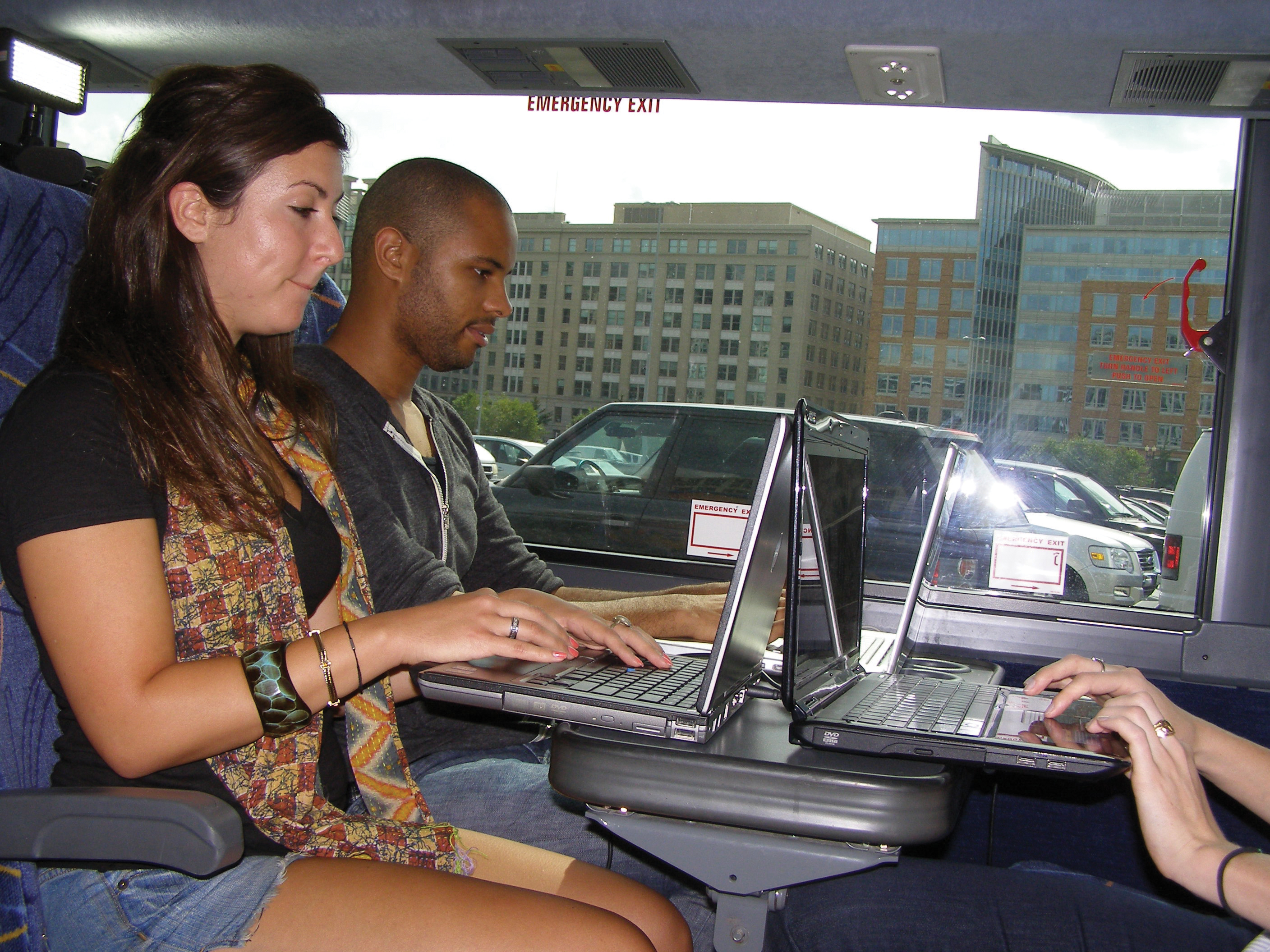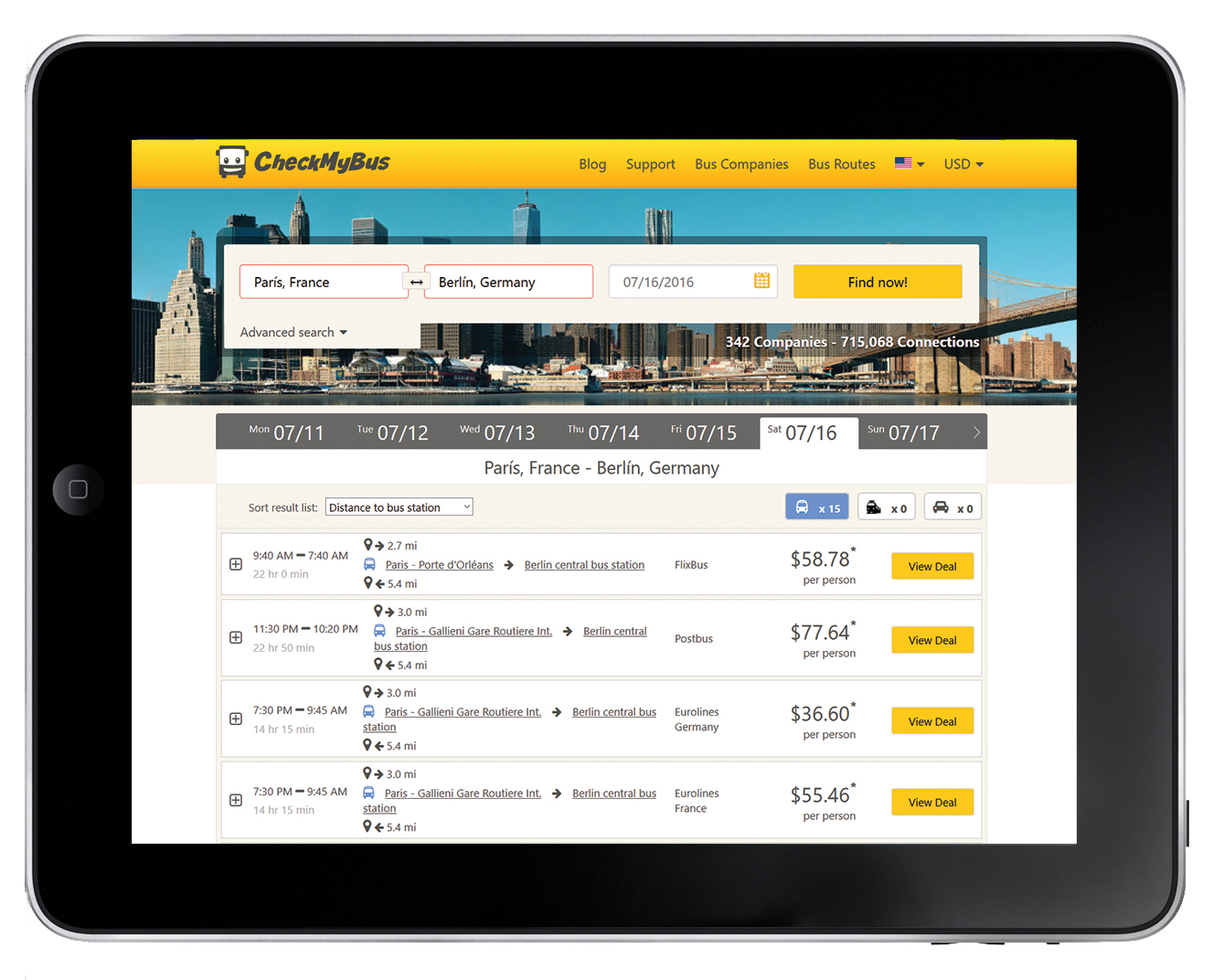David Crawford finds evidence of a new trend in American intercity travel: that better access to data sources on the move is tempting passengers away from air travel and onto surface modes. In the US the ease of use of Portable Electronic Devices (PEDs) is successfully wooing long-distance travellers away from airlines and onto surface public transport, according to just-published research. Using data from field observations of 7,028 passengers travelling by bus, air and train in 14 US states and the Distri

Keeping in touch on a US Megabus service
David Crawford finds evidence of a new trend in American intercity travel: that better access to data sources on the move is tempting passengers away from air travel and onto surface modes
In the US the ease of use of Portable Electronic Devices (PEDs) is successfully wooing long-distance travellers away from airlines and onto surface public transport, according to just-published research. Using data from field observations of 7,028 passengers travelling by bus, air and train in 14 US states and the District of Columbia, Chicago-basedThe research, claimed to be the first carried out on the subject in North America, set out to discover which modes of travel are most amenable to the use of PEDs and how their use has changed people's perceptions of the importance of speed in their chosen method of travel.
It found PED access to be proving to be a growing incentive for travellers to choose modes that directly link the central business districts of major cities, and so save on airport transfer times. Other convenience factors that emerge in contrast with air travel include often restricted space for stowing or using laptops, as airlines have faced pressure to increase the number of passenger seats in economy class.
Again, post-9/11 security regulations have led many travellers to bring on board only the smallest of PEDs. On the average US commercial flight, only 17.6 per cent of passengers are using them at any given point, reflecting the airborne travel environment.
Passenger trains, by contrast, have natural advantages over airlines with their capability for electronic equipment to be used continuously throughout long trips, pre- and post-boarding, and the potential for more spacious configuration of rail coaches.
Again, there are no constraints on the use of cell phones, although coverage can be inconsistent, with dead spots in terminal areas and on routes that cross rural areas. Buses, by contrast, benefit from largely uninterrupted mobile phone signals, thanks to the prevalence of masts along the interstate highways that they ply.
So buses are providing the real breakthrough. Chaddick, which carries out an annual analysis of the volume of service provided by intercity bus lines, has found that, at randomly chosen locations on lengthy trips, 39.6 per cent of passengers on 'kerbside' buses are now using some form of portable technology.
(Kerbside services, run by operators such as recent entrant
The kerbside usage figure is two percentage points higher than that for conventional heavy rail trains run by
Commuter rail services in the Boston and San Francisco conurbations were the first train operators to bring in wireless internet in the US, in 2007, ahead of Amtrak.
But PED use on the national carriers Acela Express, introduced in 2009, is now higher than on kerbside buses on weekdays (although it is lower at weekends). (Acela is currently the US's only genuine high-speed rail service, running modern tilting trains along the busy Northeast Corridor (NEC) that links Washington, DC, Baltimore, Philadelphia, New York and Boston.)
Amtrak is now moving on by installing Wi-Fi on its Capitol Corridor linking Sacramento, Oakland (near San Francisco) and San Jose in northern California. For the foreseeable future, however, wireless internet is likely to be available on only a restricted percentage of its services.
Problems include the frequent occurrence of tunnels and the configurations and capacity of trains. In the national context, North America is lagging behind Europe in providing a growing network of high-speed trains to compete with both airlines and road-based public transport.
Free Wi-Fi
With buses consequently leading the trend towards technology-enhanced travel in the US, Chaddick has found that it is earning its reward. Intercity services expanded by 5.1 per cent between 2008 and 2009, a rate of growth higher than all other major modes for the third year in succession. Over the same period, commercial airlines departures fell by 6.8 per cent and Amtrak train kilometres by 1 per cent, while car travel remained flat.While lower fares offer a partial explanation for this growth, over 90 per cent of the rise is represented by kerbside bus operators with free Wi-Fi, largely in the NEC. Baltimore and Philadelphia services have been growing particularly strongly during 2009.
These growth figures reflect the enthusiasm with which US bus operators have seized the opportunity to deliver wireless internet to travellers after decades during which the experience on offer to their intercity passengers barely progressed. First in the field, in summer 2007 was
This high-specification express service connecting Washington, DC and New York reported a 35 per cent growth in business over the period July 2008-July 2009. It has a weekly tally of 2,500 passengers paying an average US$26 for their tickets.
DC2NY was followed in March 2008 by BoltBus, a joint venture between
By end-2009, it was operating 77 buses and serving three additional cities, Baltimore, Boston and Philadelphia. It has recently clocked up its two millionth passenger.
Next came
Greyhound itself, which tends to run from bus station to bus station, has been slower to follow the trend. By end-2009, however, it had added over 100 new buses to its routes serving the northeastern US, the first to carry free Wi-Fi and powerpoints. While the company says it has no present plans to retrofit older vehicles, all new buses added to its fleet in future will be equipped.
User demographics and habits
Chaddick attributes the high level of PED usage on kerbside buses to the young and upwardly mobile demographic of their riders, who are experienced in making good use of modern technology. Most buy their tickets online and a significant share, display their electronic receipt on their smart phone on boarding, which typically works differently than with other modes.While air and rail passengers, for example, tend to switch off their PEDs while showing their ID and making their way to their allocated seats, kerbside bus passengers need only a few seconds to get themselves settled. After showing their ticketless confirmation on an LCD screen when boarding, they can simply carry on using their PED.
BoltBus riders, FirstGroup America's Bonnie Bastian told
"Due to amenities such as extra legroom, the majority tend to carry a laptop or have a data-enabled phone. Since launching BoltBus Mobile, and enabling passengers to buy a ticket by mobile phone, we have seen a sizable increase in sales, further proving that our riders tend to be technologically savvy."
The demographics show fewer Greyhound riders being in the 18-34 age group or receiving higher education. For both groups, of course, cost is an important factor; BoltBus tickets cost an average US$15, which can work out at a third of the price of a train ticket.
Chaddick acknowledges that, as against low fares, PED access may not be the main factor in boosting bus travel but adds that the evidence suggests that it is important in explaining the industry's continued growth in the midst of difficult economic circumstances.
The research has also identified mode-influenced differences in technology use, as between audio-based devices, (such as mobile phones or digital music players with earphones) and visual, LCD screen-based ones (such as laptops and smart phones).
On kerbside buses, it found, over half of PED users are involved in the former; while, on trains, users of vision-based PEDs outnumber those in the audio category by a factor of more than 2:1. Megabus President and COO Dale Moser says that over 50 per cent of his company's passengers use WiFi and that more and more are using the connection.
The types of PED that US bus and train travellers use tend to remain largely consistent during journeys, despite a slight tendency for kerbside bus riders to move on from audio- to visual-based activities.
The research concludes that the growing prevalence and sophistication of portable electronic technology is diminishing the perceived cost of time spent on buses and trains for many travellers. The trend is likely to continue with increasing levels of communication via emails, text messages and social interaction sites such as Facebook, and the expansion of 3G and 4G wireless networks.
Chaddick now plans to extend its research by developing a larger national sample during 2010.











